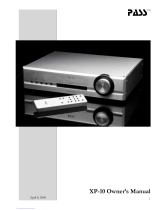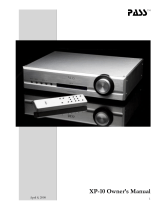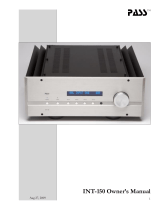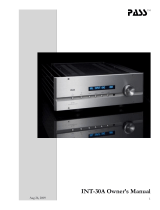Mark Levinson 33 User manual
- Category
- Audio amplifiers
- Type
- User manual
This manual is also suitable for

Madrigal Audio Laboratories, Inc.
Operating Manual
Mark Levinson
®
Nº 33
Reference Monaural
Power Amplifier

2
CAUTION
RISK OF ELECTRIC SHOCK
DO NOT OPEN
CAUTION: TO REDUCE THE RISK OF ELECTRICAL SHOCK, DO
NOT REMOVE COVER. NO USER-SERVICEABLE PARTS INSIDE.
REFER SERVICING TO QUALIFIED PERSONNEL.
WARNING: TO REDUCE THE RISK OF FIRE OR ELECTRIC SHOCK, DO
NOT EXPOSE THIS APPLIANCE TO RAIN OR MOISTURE.
The lightning flash with arrowhead symbol, within an equilateral triangle, is intended to
alert the user to the presence of uninsulated “dangerous voltage” within the product’s en-
closure that may be of sufficient magnitude to constitute a risk of electric shock to per-
sons.
The exclamation point within an equilateral triangle is intended to alert the user to the
presence of important operating and maintenance (servicing) instructions in the literature
accompanying the appliance.
Marking by the “CE” symbol (shown left) indicates compliance of this device with the EMC
(Electromagnetic Compatibility) and LVD (Low Voltage Directive) standards of the
European Community.
The information contained in the manual is subject to change without notice. The most current version of this manual will
be posted on our web site at http://www.madrigal.com.

3
Important Safety Instructions
Please read all instructions and precautions carefully and completely before operating your Mark Levinson
®
power amplifier.
1. ALWAYS disconnect your entire system from the AC mains before connecting or disconnecting
any cables, or when cleaning any component.
2. This product must be terminated with a three-conductor AC mains power cord which includes
an earth ground connection. To prevent shock hazard, all three connections must ALWAYS be
used.
3. AC extension cords are not recommended for use with this product.
4. NEVER use flammable or combustible chemicals for cleaning audio components.
5. NEVER operate this product with any covers removed.
6. NEVER wet the inside of this product with any liquid.
7. NEVER pour or spill liquids directly onto this unit.
8. NEVER block air flow through ventilation slots or heatsinks.
9. NEVER bypass any fuse.
10. NEVER replace any fuse with a value or type other than those specified.
11. NEVER attempt to repair this product. If a problem occurs, contact your Mark Levinson
®
re-
tailer.
12. NEVER expose this product to extremely high or low temperatures.
13. NEVER operate this product in an explosive atmosphere.
14. ALWAYS keep electrical equipment out of the reach of children.
15. ALWAYS unplug sensitive electronic equipment during lightning storms.

4
From all of us at Madrigal Audio Laboratories, thank you for choosing the
Mark Levinson Nº 33 Reference Monaural Power Amplifier.
A great deal of effort went into the design and construction of this precision
device. Used properly, it will give you many years of enjoyment.

5
Table of Contents
Unpacking the Nº33 ................................................................................... 6
Handling the Shipping Crate ............................................................................ 6
Unpacking Procedure ....................................................................................... 6
Placement Considerations ........................................................................ 9
Ventilation ........................................................................................................... 9
Spiking the Amplifier ........................................................................................ 10
Operating Voltage .................................................................................... 11
Nº33 AC mains current requirements ..................................................... 12
Nº33 rear-panel label ............................................................................... 12
Special Design Features........................................................................... 13
Massive Power Supply ..................................................................................... 13
AC Regeneration ............................................................................................. 13
Fully balanced design ..................................................................................... 14
True Voltage Source ........................................................................................ 14
Extensive Protection ........................................................................................ 15
Front Panel ................................................................................................. 16
Rear Panel ................................................................................................. 17
Remote turn-on tip polarity ..................................................................... 20
Care & Maintenance................................................................................ 23
U.S. and Canadian Warranty ................................................................... 24
90-Day Limited Warranty ................................................................................. 24
Five Year Extended Warranty ......................................................................... 24
Obtaining Service ..................................................................................... 25
Specifications ............................................................................................ 26
Dimensions: Nº33 ...................................................................................... 27

6
Unpacking the Nº33
Handling the
Shipping Crate
The shipping weight of each of your Nº33 Reference Monaural Power Amplifiers
is approximately 435 pounds (198 kg). Any freight this massive must be handled
with extreme care to avoid injury. At least two strong people are required (more
is nice) to unpack the Nº33 amplifiers safely once they have been delivered to
the appropriate location in their shipping crates.
Included with your new Mark Levinson amplifier is two pairs of knit, white
gloves designed to assist you in the initial unpacking and placement of your new
purchase. Please accept them as a token of our appreciation for having purchased
one of our products.
Warning! Under no circumstances should you consider unpacking your
amplifier without adequate assistance, as both personal
injury and damage to the product is likely unless you follow
the procedures listed below.
The shipping crates used for transporting the Nº33 power amplifiers should be
kept upright (as indicated by the arrows on the outside of the crates) at all times
during the unpacking procedure.
Save all packing material for future use. In the event that you need to ship your
Nº33 amplifiers, only their original, purpose-designed shipping crates are accept-
able. Any other method of shipping these heavy products will almost certainly
result in damage to the amplifiers.
Unpacking Procedure The shipping crates for your amplifiers are modular in design to facilitate the
packing and unpacking of these massive products. Nonetheless, there is no es-
caping the fact that these amplifiers are heavy.
Caution! Do not attempt to lift the Nº33 from its packing crate alone.
Never attempt to lift a Nº33 power amplifier while bending
from the waist.
Always stand as straight as possible and use your leg muscles
to lift the amplifier.
Never attempt to lift the entire amplifier at one time (even with
two people). Instead, always lift either one end or the other,
leaving the remaining end to be supported by the base of
the shipping crate or the floor.

7
To safely unpack the Nº33 amplifier:
1 CAREFULLY CUT THE NYLON STRAPPING AROUND THE CRATE
These straps may be under some tension, and the ends may snap outward
when that tension is first released. Stand to one side when cutting each ny-
lon strap to avoid any chance of the strap contacting you.
2 REMOVE ALL CLAMPS AND THE FOUR SCREWS HOLDING THE TOP OF
THE CRATE TO THE FOUR SIDES
You may use a large screwdriver or a small crowbar to pry the clamps off
the crate. Set these clamps aside. (Save all shipping materials for possible
future use.)
Two screws are located at each end of the short side of the top of the crate.
Remove and save these four screws, which secure the top of the crate to the
sides. (Save all shipping materials for possible future use.)
3 LIFT OFF THE TOP OF THE CRATE, AND SET IT ASIDE
The various pieces of the crate are designed to fit snugly into one another.
Do not be surprised if removing the top requires some effort, especially if
unpacking takes place in a humid climate where the wood may have
swelled slightly from the moisture.
4 LIFT ALL FOUR SIDES UP AND AWAY FROM THE BASE
The sides and ends may be lifted up and out of their respective slots in the
base of the crate, and set to aside. As with the top, this may require some
effort. You should now have the Nº33 standing on the wooden base of the
crate, inside its plastic shipping bag.
5 USING A RATCHETED SOCKET WRENCH, REMOVE THE FOUR BOLTS
HOLDING THE Nº33 TO THE BASE OF THE CRATE
The Nº33 is attached to the base of its shipping crate with four bolts, acces-
sible between the pieces of blue, dense foam along the sides of the base.
These bolts attach directly to the bottom of the feet of the Nº33 from un-
derneath, and have
9
⁄16" hexagonal heads. Using a ratcheted socket wrench,
remove these four bolts from underneath each amplifier.
6 REMOVE THE WOODEN RETAINING BAR FROM THE FRONT OF THE BASE
Two more bolts with
9
⁄16" hexagonal heads hold this retainer in place. Re-
move the bolts and the retaining bar and set them aside.
7 WITH AT LEAST TWO STRONG PEOPLE, CAREFULLY SLIDE THE Nº33 FOR-
WARD, OFF THE CRATE’S BASE AND ONTO THE FLOOR
Understand this step completely before attempting it. The Nº33 is ex-
tremely heavy and must be handled with great care to avoid possible per-
sonal injury or damage to the unit when attempting to lift it.

8
Your Mark Levinson
®
Nº33 power amplifiers incorporate heavy duty casters
to facilitate their movement. If your flooring is even slightly fragile, be ad-
vised that significant pressure is generated by the Nº33’s approximately 350
pounds (160 kg) being supported by four round casters. Before you remove
the Nº33 from its shipping crate’s base, you may want to take measures to
protect delicate flooring from possible damage.
With two people at the front of the amplifier to support its weight, carefully
slide the amplifier forward. (A third person may be needed to hold the
crate bottom in place as the amplifier is slid forward.) As the front casters
clear the front edge of the crate, the two people in front must begin to sup-
port the weight of the front half of the amplifier. There is a “handle” built
into the sculpted faceplate for this purpose, just above the Mark Levinson
logo. Alternatively, you may also grip the front heatsinks. While supporting
the front of the amplifier, continue sliding the amplifier forward until the
center section of the amplifier has cleared the edge of the crate’s base. The
front of the amplifier may then be lowered gently to the floor.
With the amplifier supported by the floor in the front and the crate in the
rear, both people should move to the rear of the amplifier. Gripping the rear
heatsinks, lift the rear end of the amplifier and slide the base of the crate
away. (A third person is helpful in this, if available.) Gently lower the rear of
the amplifier to the floor, allowing it to come to rest on its casters.
Congratulations. The hard part is over.
After unpacking your Nº33 power amplifiers, keep all packing materials for
future transport. Shipment of the amplifier without the original packing mate-
rial will almost certainly result in damage to the amplifier, and is not recom-
mended.
Locate and remove all accessory items from the accessory cartons. Accessories for
each amplifier include:
4 machined aluminum spiked “feet”
Carefully inspect your amplifier for possible damage. If you discover any, see your
Mark Levinson dealer immediately.
Important: When it comes to high current AC wiring such as the Nº33 will
typically use, building regulations and electrical codes vary
from region to region (sometimes even from one municipality
to the next). For this reason, it is impossible for us to anticipate
the requirements of your area with regard to high current AC
hookups. Please review this manual’s section on Operating
Voltage and contact a local electrical contractor for advice
on connecting your Nº33 to the AC mains power in your area.

9
Placement Considerations
PRECAUTION
For your protection, review “Important Safety Instructions” and
“Operating Voltage” before you install your Nº33.
Your Mark Levinson Nº33 power amplifiers are specifically designed to stand on
the floor, and must be used as freestanding units. In most installations, locating
them near the loudspeakers is best. Obviously, this approach minimizes the
length of the speaker wires and necessitates longer interconnecting cables from
the preamplifier to the power amplifiers. The advantage to this strategy lies in the
fact that the interconnecting cables carry low-current signals which are more
readily transmitted over distances with great accuracy than are the necessarily
high current signals required by loudspeakers.
Note that adequate clearance for the AC cord and connecting signal cables must
be left behind each Nº33. We suggest leaving at least six inches (15 cm) of free
space behind each Nº33 so that all cables have sufficient room to bend without
crimping or undue strain.
Each amplifier should also be placed in such a way that the power switch on the
rear panel is easily accessible. This switch disconnects power from even the su-
pervisory power supply, resulting in effective disconnection of the amplifier from
the AC mains. (Note that under these conditions, the amplifier cannot respond to
remote-turn-on commands, etc.)
Ventilation Your Mark Levinson Nº33 power amplifiers have been designed to complement
your listening room visually, with a tall and narrow frontal area which reduces
their effective “footprint” and makes them far more presentable than would be
the case with a more traditionally proportioned design. As a result, they can be
more easily placed beside your loudspeakers. As freestanding units, the Nº33 am-
plifiers normally will have no problem with ventilation.
Each of your Nº33 power amplifiers dissipate approximately 800 watts of energy
as heat when “at idle.” It is therefore normal and perfectly safe for them to run
warm. They do, however, require free air flow around them to allow adequate
heat dissipation through air circulation. The top plate and heatsinks of the Nº33
must be kept free from any obstruction which would reduce the free flow of air.
If your amplifier must be located inside an enclosure of some sort that restricts
airflow, we strongly advise using some fans to increase ventilation through the
enclosed space. If the amplifiers become too warm to touch, they are receiving
inadequate ventilation. While they are fully protected against overheating, no one
enjoys interrupted listening sessions.
Mechanical drawings are included in this manual to facilitate special installations
and custom enclosures where necessary (see “Dimensions” at the end of this
manual).

10
Spiking the Amplifier Once you have established locations for your amplifiers, you may elect to immo-
bilize them by using the four spiked “feet” included with each amplifier. These
machined aluminum parts fit snugly over the heavy duty casters on the bottom
of each amplifier and provide fixed, rounded points which prevent the amplifiers
from rolling about on their casters. Given the weight of the amplifier, sharply
pointed spikes are neither needed nor desirable.
If you elect to “spike” your amplifier, enlist the help of another person. Carefully
tip the amplifier to one side, toward your assistant (who is supporting it). While
the Nº33 is balanced on two feet, push a spike over each exposed caster, snugly
covering the entire caster assembly. Gently lower the amplifier and repeat the
process on the other side.

11
Operating Voltage
Your Mark Levinson Nº33 Reference Monaural Power Amplifier is characterized by
its remarkable ability to pass a musical signal with utter integrity, regardless of
how demanding that signal and the loudspeakers used might be. When called
upon to do so, the Nº33 is capable of generating truly prodigious power levels
into virtually any speaker load, on either an instantaneous or a continuous basis.
Depending on the demands placed on the Nº33 by your loudspeaker and your
listening habits, it is possible for the quality and current capability of your electri-
cal service to become the limiting factor in the performance of your system.
Given its status as a Reference product, any such limitation (even if only rarely
encountered) is unacceptable. As a result, the Nº33 has been designed to be ca-
pable of taking advantage of dedicated high current AC mains supplies which
cannot limit its performance. The Nº33 may be ordered in either a High Current
(HC) or an Ultra High Current (UHC) configuration, depending on the require-
ments of any given installation. (Due to CE regulations, only the UHC, 230V ver-
sion of the Nº33 is available in European Union countries.)
The UHC configuration of the Nº33 accepts a dedicated high voltage (200–240
volts, depending on the country), high current (30–35 amperes, depending on
local electrical codes) AC power source. These high current lines are commonly
used in residential construction for electric stoves, clothes driers, and other de-
manding appliances, making their installation fairly routine for any electrical con-
tractor… although this may be the first time your contractor has installed such
lines for a stereo system!
Important: When it comes to high voltage/high current AC wiring such as
the Nº33 may use, building regulations and electrical codes
vary from region to region, and even from one municipality to
the next. For this reason, it is impossible for us to anticipate the
requirements of your area with regard to high current AC
hookups. Please review this section carefully and then
contact a local electrical contractor for advice on
connecting your Nº33 to the AC mains power in your area.
The Mark Levinson Nº33 amplifiers may be factory-set for 100V, 120V, 200V, 210V,
220V, 230V or 240V AC mains operation at either 50 or 60Hz. Depending on local
electrical codes and regulations, the plug on the supplied AC input module may
need to be replaced by a local, licensed electrical contractor. The maximum cur-
rent requirements at these various voltages under various test conditions are
listed in the table shown on the next page.

12
Nº33 AC mains
current requirements
100V 120V 200V 210V 220V 230V 240V
Off <.3 <.3 <.2 <.2 <.2 <.2 <.2
Standby 2.1 1.7 1.1 1 1 0.9 0.9
On, at idle 8.4 7 4.2 4 3.8 3.7 3.5
300w @ 8Ω* 14.7 12.3 7.4 7 6.7 6.4 6.1
600w @ 4Ω* 23.1 19.3 11.6 11 10.5 10 9.6
1200w @ 2Ω* 32.5 27.5 16.5 15.5 15.0 14 13.6
2400w @ 1Ω* n/a
†
n/a
†
31.5 30.0 28.6 27.5 26
* power ratings are continuous (rms) with less than 0.5% THD, from 20-20,000 Hz.
†
not applicable, since continuous current requirements exceed available AC mains service.
It is important to understand that these are worst-case requirements under severe
test conditions, which are extremely unlikely to be encountered in normal use.
The power demands that a single Nº33 might conceivably make when being
used to reproduce music with actual loudspeakers are substantially lower, safely
within the normal abilities of 100V and 120V, 15 ampere lines. Still, for the best
possible performance with extremely difficult loads, we recommend installing a
dedicated AC line for each amplifier of at least 200-volt and 30-ampere capability.
The operating voltage of the Nº33 cannot be changed by the user, and any at-
tempt to do so will void the warranty. If you need to change the operating volt-
age of your Nº33 power amplifiers, or if the voltage indicated on the rear panel
label is not available in your area, contact your Mark Levinson dealer for assis-
tance.
Nº33 rear-panel label

13
Special Design Features
Congratulations on your purchase of Mark Levinson Nº33 Reference Monaural
Power Amplifiers. While your new amplifiers are straightforward in their everyday
use, they include several design features which are responsible for their outstand-
ing performance. In particular, the Nº33 Reference Monaural power amplifiers
defy the accepted wisdom that it is impossible to design a large, powerful ampli-
fier that also has all of the finesse of the finest smaller amplifiers. A few of the
technical highlights that make this possible are given below.
Massive Power Supply The Nº33 incorporates two 2.45 kVA low noise toroidal transformers in a fully
balanced power supply. In this design, there is a separate power supply (each
with its own power transformer) for both the inverting and non-inverting halves
of the amplifier. Twelve 39,000 µF low ESR capacitors are used in each amplifier.
The power supply of each Nº33 provides almost
1
⁄2 a Farad of capacitance and
1200 Joules of energy storage.
Heavy oxygen-free copper bus bars enhance the efficiency of power distribution
within the amplifier and eliminate variances introduced by the wiring harnesses,
etc. more commonly found even in high performance amplifiers. High frequency
power supply bypass is accomplished on individual PC boards by a total of 56
components of several film types. The resulting uniformly low power supply im-
pedance seen by the various circuits within the Nº33 lays the foundation for both
the massive power and the extraordinary finesse that characterizes this amplifier.
AC Regeneration In recent years, the detrimental sonic effects of noisy, unbalanced AC mains sup-
plies have become widely known. Various passive AC “line conditioners” are avail-
able for use with line level components such as preamplifiers and digital audio
processors to address these problems. In most cases, these line conditioners pro-
vide some filtering of the AC mains, along with some measure of surge protec-
tion. None of these devices may be used to good effect with power amplifiers,
however, since they cannot handle the large instantaneous currents which power
amplifiers require during normal operation. In effect, passive line conditioners
become a “bottleneck” in the otherwise free flow of power through the amplifier
to the speakers, reducing dynamic impact and musicality.
In the Nº33, a more sophisticated approach is used that provides greater line con-
ditioning benefits than the commercially available passive devices can hope to
provide, while simultaneously avoiding any performance “bottlenecks.”
A distortion-free 60 Hz sinewave is regenerated within the Nº33, and then used
to power a separate power supply dedicated to all the voltage gain stages. AC
power is delivered from the wall to the primary supply of the Nº33, where it is
rectified, filtered and regulated into positive and negative DC voltages. A portion
of this DC power is then used to drive an oscillator circuit which regenerates a
pure 60 Hz sinewave without any of the noise or contamination so common to
the AC mains as delivered to our homes by power utilities.
The regenerated, pure sinusoidal AC wave is then sent to a dedicated secondary
power supply, where it is converted to positive and negative DC power to be
used by all of the voltage gain stages. This dedicated supply for voltage gain
stages benefits from having a truly balanced source (unlike the dissimilar imped-

14
ances of AC mains line and neutral), as well as from the total elimination of AC
mains fluctuations and noise. As a result, the critical voltage gain stages of the
Nº33 operate in a highly optimized environment, and are able to pass along sig-
nificantly more low-level resolution and detail in the musical signal that they am-
plify.
Fully balanced design A truly balanced input topology eliminates the need for an input buffer amplifica-
tion stage and allows the first stage differential amplifier to be driven directly by
the source. Matched impedances are presented to the source and both signals
travel through identical circuit paths. Voltage gain is implemented on a cyanate
ester circuit board for superior sonic performance and consistency.
Painstaking attention to layout of the amplifier was essential to minimize mag-
netic field distortions possible with such a massive power delivery system, includ-
ing careful mirror-imaging of circuits to cancel magnetic fields. Balanced output is
accomplished through the use of two identical amplifiers. A balanced input signal
remains balanced throughout the Nº33. Rejection of common mode noise and
distortion is obtained when the two halves finally meet: in the loudspeaker’s
voice coil.
True Voltage Source The Nº33 power amplifier operates as a virtually perfect textbook case of a “volt-
age source.” This is to say that the Nº33 will maintain whatever the appropriate
voltage might be at any moment (given the demands of the music) without any
particular regard for the current demands of the loudspeaker. Whether the loud-
speaker requires one amp or one hundred amps of current at that instant, the
Nº33 will deliver it.
Because of this “voltage source” characteristic, the Nº33 doubles its power output
every time the loudspeaker impedance is cut by half. Its continuous rated power
is 300 watts at 8Ω; 600 watts at 4Ω; 1200 watts at 2Ω; and 2400 watts at 1Ω—
assuming the electrical circuit in the wall can support these extraordinary power
levels. A 1Ω test at continuous maximum power requires about 62 amperes at
120V and 31 amperes at 240V. (The laws of physics refuse to be cheated. Long-
term, you cannot deliver more power into the speaker than you can pull from the
wall.)
Sixty TO-3 output transistors are distributed in the four main heatsinks of each
Nº33 to conduct and control the flow of its prodigious power capabilities to the
loudspeaker. There are fifteen complementary pairs of output transistors in each
of two output stages (inverting and non-inverting) within each amplifier.
No known loudspeaker can absorb the continuous full power capability of the
Nº33. (Nor would you want to be present in the room were you to find one that
could do so.) However, many high quality loudspeakers may require these rather
extreme power levels on a short term basis when reproducing music at realistic
levels. The Nº33 can answer these needs with impunity, without any power sup-
ply “sag” and without altering its sonic performance in any way. Its resultant im-
perturbable nature is reflected in the authority and control with which it repro-
duces music.
Extensive Protection Your Nº33 power amplifiers will shut themselves down if they sense any of a
number of fault conditions which could cause damage to either themselves or to
your loudspeakers. These fault conditions include

15
• the presence of DC (direct current) at the output
• either over-voltage or under-voltage conditions on the AC mains
• unsafe operating temperatures in any of several critical areas
within the amplifier
• sustained output current in excess of 80 amperes (which would
occur only in the event of a dead short across the outputs).
If any of these fault conditions is sensed while the amplifier is in either standby
or fully on, the amplifier will shut down completely (off mode, not merely
standby). Moreover, it will not turn on again until the fault condition is corrected.
In addition, the AC input to each transformer is fused to protect against excessive
current conditions such as driving shorted outputs. In-rush limiting prevents pre-
mature aging of power supply components during power-up, and switches off-
line once the power supply has been charged.
Finally, the Nº33 incorporates a controlled clipping circuit that prevents the output
devices from saturating. The harsh high frequency harmonics generated by hard-
clipped output devices are avoided by the waveshaping action of this controlled
clip circuitry.

16
MADRIGAL AUDIO LABORATORIES
R
REFERENCE
MONAURAL
AMPLIFIER
Nº 33
2
1
Front Panel
1STANDBY BUTTON
When power is first applied to the Nº33 power amplifier, and assuming the
rear panel AC mains switch is set to its on position, the amplifier remains
completely off. Pressing the front panel standby button will bring the ampli-
fier from completely off to standby. After a delay of ten seconds (to allow
all circuitry to stabilize), subsequent pressing of the power button will
toggle the Nº33 between standby mode and fully on. Power consumption
of the Nº33 when fully on and at idle is approximately 600 watts.
To turn the amplifier completely off, press and hold the standby button for
approximately one second, until the front panel indicator light turns off.
2 INDICATOR LIGHT
The indicator light shows the operational status of your Nº33:
Full brightness indicates that the Nº33 is on and ready to be used.
Blinking slowly indicates the unit is in standby.
Dimly lit indicates that the main power supply is completely off, leaving
only the supervisory supply operational.
Completely off indicates that the rear panel AC mains switch has been
turned off, disengaging even the supervisory power supply.
If the amplifier will not turn on, you may want to check the rear panel AC
mains switch
, your AC connections, or have your dealer inspect the rear-
panel fuses (which are not user-serviceable).

17
PUSH
slave out
remote turn-on jacks
communications ports
slave in
1
2
4
5
3
Rear Panel
Caution! Turn the volume on your preamplifier all the way down before
attempting to connect anything to your Mark Levinson Nº33.
1 SINGLE-ENDED INPUTS
These RCA connectors accept single-ended inputs from preamplifiers with
single-ended (RCA) outputs. Both inverting and non-inverting inputs are
provided. Single-ended input signals are converted to balanced signals im-
mediately upon being received at the Nº33, and are handled as balanced
signals thereafter.
If your preamplifier does not support balanced connection to the power
amplifier, connect the single-ended output of your preamplifier to the non-
inverting RCA input on the Nº33. Repeat this process for the other Nº33(s)
in your system, being certain to be consistent throughout. To reduce the
chance of noise pickup at the (otherwise unterminated) inverting input,
short the inverting input of each amplifier by inserting the provided U-
shaped shorting strap between pins #1 and #3 of the XLR connector to re-
duce the chance of noise pickup at the (otherwise unterminated) input. (As
delivered from the factory, this shorting strap is already installed.)
Important! If you use single-ended interconnection with the Nº33, you
must take care to use one input or the other (inverting or non-
inverting) consistently throughout your system. If you mix their

18
use, the amplifiers will operate out of phase with each other,
resulting in a loss of bass and poor imaging.
Although the best form of balanced interconnection is via a balanced cable
and XLR connectors, it is possible to operate the Nº33 in a balanced con-
figuration by using both inverting and non-inverting RCA inputs
simulataneously. This approach is generally less desirable, however, since
separate single-ended cables will be more susceptible to noise pickup than
a single balanced cable. If this approach is taken, you must remove the
shorting strap from the XLR input. Save it for possible use at a later date.
2 BALANCED AUDIO INPUT
Accepts a signal from a preamplifier with balanced outputs via a high qual-
ity XLR connector. If connection to the preamplifier is made with a bal-
anced interconnecting cable, it is important to remove the shorting plug
from between pins #1 and #3 of the XLR input which was placed there
prior to shipment from the factory. Save it for possible use at a later date.
The pin assignments of this XLR-type female input connector is:
PUSH
21
3
Pin 1: Signal ground
Pin 2: Signal + (non-inverting)
Pin 3: Signal – (inverting)
Connector ground lug: chassis ground
These pin assignments are consistent with the standards adopted by the
Audio Engineering Society. Refer to the operating manual of your balanced-
output preamplifier to verify that the pin assignments of its output connec-
tors correspond to your Mark Levinson Nº33. If not, wire the cables so that
the appropriate output pin connects to the equivalent input pin.
3 COMMUNICATIONS LINK AND REMOTE TURN-ON INPUTS
The Nº33 may be controlled by a “linked” Mark Levinson 30-series pream-
plifier when the slave in communications port is connected to the master
port of the preamplifier. Subsequent Nº33 amplifiers may be “daisy chained”
from the first Nº33’s slave out to their slave in port, up to a maximum of
six amplifiers total.
slave out
remote turn-on jacks
communications ports
slave in
A “straight-through,” six conductor Link cable with six-conductor modular
connectors on both ends is used to connect the preamplifier to the first
power amplifier. Such a cable is made (counter-intuitively) by incorporating
a 180° twist into the cable before terminating it, as shown below:

19
To Nº38 Master To Nº33 Slave In
Locking tabLocking tab
A different Link connector configuration is used for the “daisy-chain” of one
amplifier to the next, to minimize the opportunity for mis-wiring. In effect,
this cable is identical to the one between preamplifier and power amplifier
except that it uses pins 1 through 6 of an eight-conductor modular connec-
tor at one end, as shown below:
To Nº33 Slave Out To Nº33 Slave In
Locking tabLocking tab
(Note that the pins are numbered 1 through 8 from left to right when the
locking tab is down and the metal contacts are pointing away from you.)
When connected in this manner, the power amplifiers will be toggled be-
tween
standby and fully on when the preamplifier goes between standby
and fully on. In addition, should a fault condition cause the amplifier’s pro-
tection circuitry to activate, the Nº33 can report the nature of the problem
to a linked Mark Levinson preamplifier via this communications link. If this
occurs, the preamplifier will display the number of the amplifier at fault
(AMP1 being the first amplifier in the daisy chain, AMP2 being the second
amplifier, and so on). The preamplifier will also indicate the nature of the
fault condition with one of the following codes:
Code Fault Condition
HOT! thermal shutdown
DCO! uncorrectable DC offset
ZAP! excessive output current
Additional remote turn-on jacks provide compatibility with a wide range of
products, to facilitate remote turn-on and turn-off in systems which do not
include a Mark Levinson 30-series preamplifier (which would normally use
the Mark Levinson Communications Link described above). These
1
⁄8" (3.5
mm) “mini-jacks” allow other components to bring the Nº33 power amplifi-
ers in and out of standby. Two such mini-jacks are provided to allow
“daisy-chaining” of multiple amplifiers. When “daisy-chaining” multiple am-
plifiers, the last mini-jack in the chain must be terminated with a dummy
1
⁄8" plug [that is, an empty plug must be inserted into the
1
⁄8" (3.5 mm)
jack].
This remote “trigger” will be operated by a 3–12 volts DC positive-polarity
pulse, of at least 100 milliseconds duration, with tip polarity as shown be-
low:
Remote turn-on
tip polarity
+–
3-12 volts for at
least 100 mS
digital input
master
analog output
digital output
slave in
slave out
Link
cable
Link
cable
Nº38
slaveany input
MADRIGAL AUDIO LABORATORIES
R
polarity
invert
display
intensity
aes/ebu emphasis
123456
standby
COMPACT DISC DRIVE
Nº 37
mode
teach ir
Nº36
MADRIGAL AUDIO LABORATORIES
R
polarity
invert
display
intensity
aes/ebu emphasis
123456
standby
DIGITAL PROCESSOR
Nº 36
mode
teach ir
MADRIGAL AUDIO LABORATORIES
R
standby
PREAMPLIFIER
Nº38
MADRIGAL AUDIO LABORATORIES
R
REFERENCE
MONAURAL
AMPLIFIER
Nº 33
MADRIGAL AUDIO LABORATORIES
R
REFERENCE
MONAURAL
AMPLIFIER
Nº 33
slave out
slave in
Link
cable
Link
cable
master
slave in
(any Mark Levinson transport)
Nº33

20
Your Mark Levinson dealer can help you take advantage of these design
features to maximize your system’s versatility.
4 SPEAKER BINDING POSTS
The Mark Levinson Nº33 is equipped with custom made, gold-plated, high-
current binding posts for output termination to a loudspeaker system. To
take full advantage of the Nº33’s sonic quality, we recommend using high-
quality speaker cable; see your Mark Levinson dealer.
Caution! NEVER connect the Mark Levinson Nº33 output terminals to
any device other than a loudspeaker.
NEVER short-circuit the amplifier's output terminals.
NEVER connect the output terminals of one amplifier to the
output terminals of another amplifier.
We recommend connecting speaker cables to the Mark Levinson Nº33by
means of a high-quality spade lug or hook lug, soldered to the cable (or
crimped with extremely high pressure).
Spade lug Hook lug
Connect a + (positive or red) output post of the Mark Levinson Nº33 to the
+ (positive or red) input terminal of the appropriate loudspeaker. [If
biwiring, repeat using the other + (positive or red) output post of the am-
plifier and the + (positive or red) input terminal of the loudspeaker.]
Connect a – (negative or black) output post of the Nº33 to the – (negative
or black) input terminal of the appropriate loudspeaker. [If biwiring, repeat
using the other – (negative or black) output post of the amplifier and the –
(negative or black) input terminal of the loudspeaker.]
5 AC MAINS CORD AND AC MAINS SWITCH
Conventional IEC standard power cords cannot be used in the Nº33, due to
the potential current requirements of Nº33 when operating into low imped-
ance loads. (The highest available current rating for an IEC standard three-
conductor connector such as is used on most stereo equipment, including
other Mark Levinson products, is 16 amperes.) Instead, the Nº33 incorpo-
rates a high current AC cord which is attached directly to the amplifier itself
via a specially-designed AC mains module, located at the bottom of the rear
panel. A high current AC connector is included with the Nº33 and may be
attached to the end of the AC mains cord.
Page is loading ...
Page is loading ...
Page is loading ...
Page is loading ...
Page is loading ...
Page is loading ...
Page is loading ...
Page is loading ...
-
 1
1
-
 2
2
-
 3
3
-
 4
4
-
 5
5
-
 6
6
-
 7
7
-
 8
8
-
 9
9
-
 10
10
-
 11
11
-
 12
12
-
 13
13
-
 14
14
-
 15
15
-
 16
16
-
 17
17
-
 18
18
-
 19
19
-
 20
20
-
 21
21
-
 22
22
-
 23
23
-
 24
24
-
 25
25
-
 26
26
-
 27
27
-
 28
28
Mark Levinson 33 User manual
- Category
- Audio amplifiers
- Type
- User manual
- This manual is also suitable for
Ask a question and I''ll find the answer in the document
Finding information in a document is now easier with AI
Related papers
-
 Mark Levinson N383 User manual
Mark Levinson N383 User manual
-
 Mark Levinson 500H User manual
Mark Levinson 500H User manual
-
 Mark Levinson 27.5 Operating instructions
Mark Levinson 27.5 Operating instructions
-
 Mark Levinson NO519 Owner's manual
Mark Levinson NO519 Owner's manual
-
Mark Levinson ML-50 User guide
-
 Mark Levinson N 331 User manual
Mark Levinson N 331 User manual
-
 Mark Levinson No532 User manual
Mark Levinson No532 User manual
-
 Mark Levinson 585 Quick start guide
Mark Levinson 585 Quick start guide
-
 Mark Levinson 53 User manual
Mark Levinson 53 User manual
-
 Mark Levinson No. 33H User manual
Mark Levinson No. 33H User manual
Other documents
-
Massive Audio BP-PS100 User manual
-
 Pass Labs XP-20 User manual
Pass Labs XP-20 User manual
-
Edge Amplifier Owner's manual
-
 Pass Labs XP-10 User manual
Pass Labs XP-10 User manual
-
 Pass Labs XP-10 User manual
Pass Labs XP-10 User manual
-
Wisdom SA Series Owner's manual
-
Harman Mark Levinson No526/No523 Dual-Monaural Preamplifier User manual
-
 Pass Labs INT-150 User manual
Pass Labs INT-150 User manual
-
Plus K-10S, K-10W Owner's manual
-
 Pass Labs 1INT-30A User manual
Pass Labs 1INT-30A User manual









































